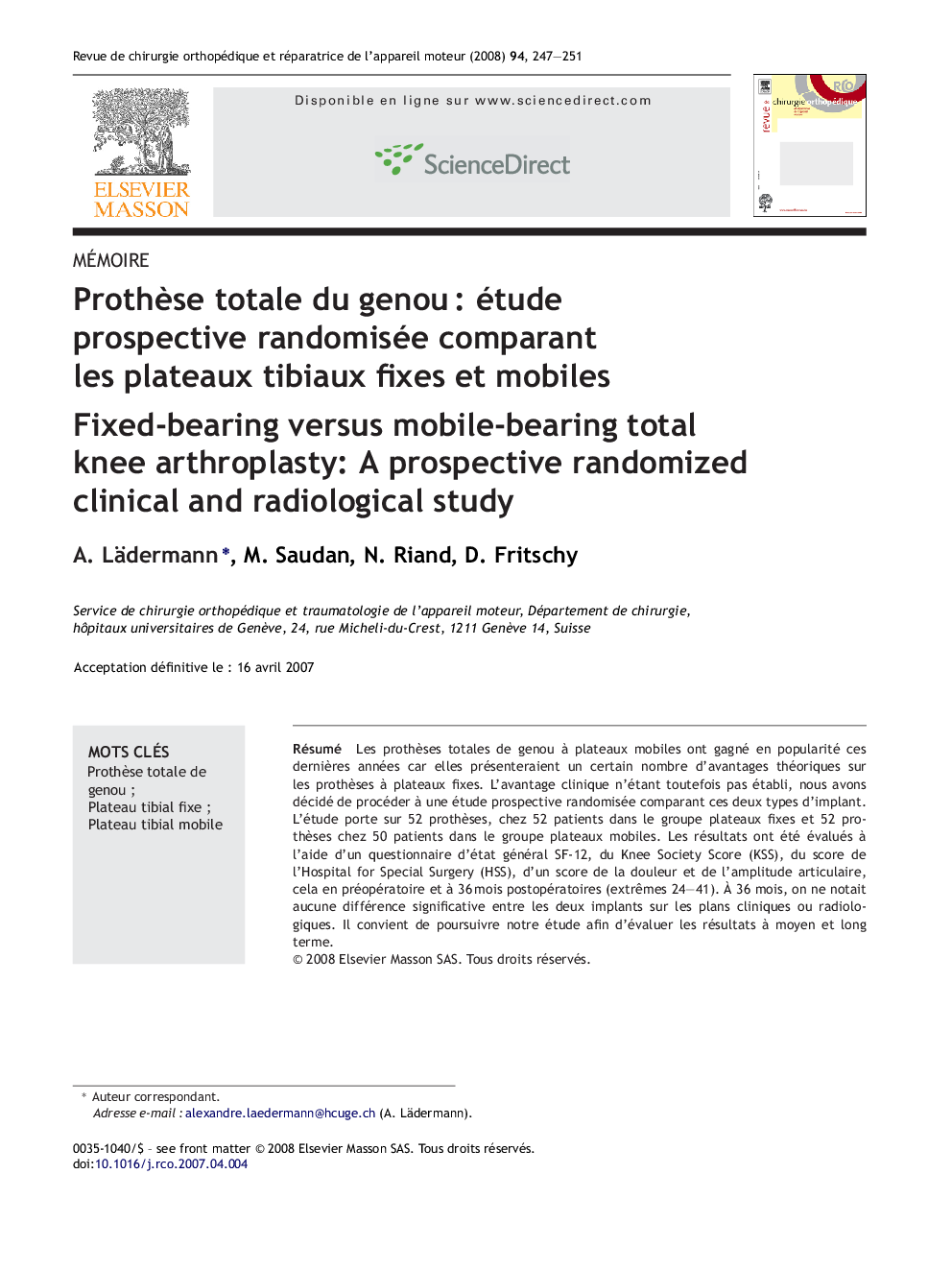| کد مقاله | کد نشریه | سال انتشار | مقاله انگلیسی | نسخه تمام متن |
|---|---|---|---|---|
| 4088362 | 1268103 | 2008 | 5 صفحه PDF | دانلود رایگان |

RésuméLes prothèses totales de genou à plateaux mobiles ont gagné en popularité ces dernières années car elles présenteraient un certain nombre d’avantages théoriques sur les prothèses à plateaux fixes. L’avantage clinique n’étant toutefois pas établi, nous avons décidé de procéder à une étude prospective randomisée comparant ces deux types d’implant. L’étude porte sur 52 prothèses, chez 52 patients dans le groupe plateaux fixes et 52 prothèses chez 50 patients dans le groupe plateaux mobiles. Les résultats ont été évalués à l’aide d’un questionnaire d’état général SF-12, du Knee Society Score (KSS), du score de l’Hospital for Special Surgery (HSS), d’un score de la douleur et de l’amplitude articulaire, cela en préopératoire et à 36 mois postopératoires (extrêmes 24–41). À 36 mois, on ne notait aucune différence significative entre les deux implants sur les plans cliniques ou radiologiques. Il convient de poursuivre notre étude afin d’évaluer les résultats à moyen et long terme.
SummaryPurpose of the studyMobile-bearing total knee arthroplasty has become increasingly popular over the last few years since this option presents several theoretical advantages compared with the fixed-bearing models. The clinical advantage remains to be demonstrated. We therefore conducted a prospective randomized trial to ascertain the potential benefits.Material and methodsThis study included patients treated by three senior orthopedic surgeons. Each group included 52 prostheses in 52 patients in the fixed-bearing group and 50 patients in the mobile-bearing group. The per- and postoperative protocols were the same for both groups. Implants were cemented in all cases and patellae were resurfaced. The SF-12, the Knee Society Score (KSS), the Hospital of Special Surgery score (HSS) and pain and joint motion were noted before and after surgery.ResultsAmong the 104 prostheses implanted, 100 were reviewed at mean follow-up of 36 months (range 24–41). One patient in the fixed-bearing group died six months after surgery from an unrelated cause. Three patients were lost to follow-up: one in the fixed-bearing group and two in the mobile-bearing group. There was no difference between groups for the SF-12, KSS, HSS, pain and joint motion measured postoperatively. Postoperative femorotibial alignment was one degree varus on average in the fixed-bearing group and zero degree in the mobile-bearing group. At last follow-up, there were no radiological signs of prosthesis loosening. One patient in the fixed-bearing group developed a deep venous thrombosis, complicated by pulmonary embolism. Two of the mobile-bearing prostheses were revised, one for patellar fracture caused by a bicycle accident and one for prosthesis infection in a patient with endocarditis 1.5 years after implantation.DiscussionThe clinical results were similar for the two groups in terms of function, pain, general status and complications. The outcome at 36 months was considered excellent or good in 90% of the fixed-bearing group and 88% in the mobile-bearing group. This study did not reveal any difference between the two groups regarding maximal flexion and anterior knee pain, two parameters which would theoretically show short-term improvement with the mobile bearing. Mid- and long-term follow will be required to confirm these findings and to determine the survival of these two types of implants.
Journal: Revue de Chirurgie Orthopédique et Réparatrice de l'Appareil Moteur - Volume 94, Issue 3, May 2008, Pages 247–251